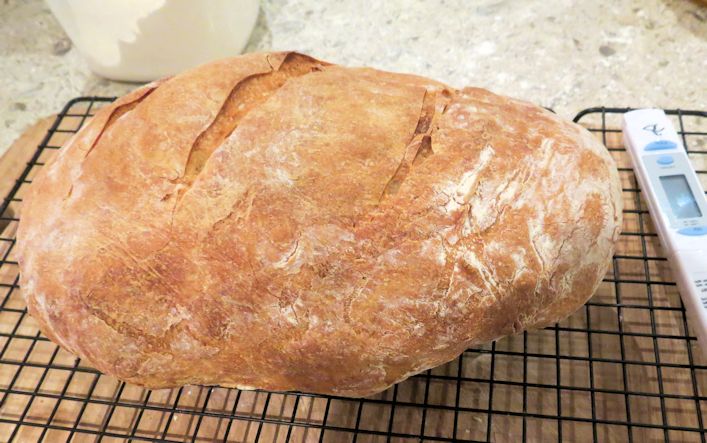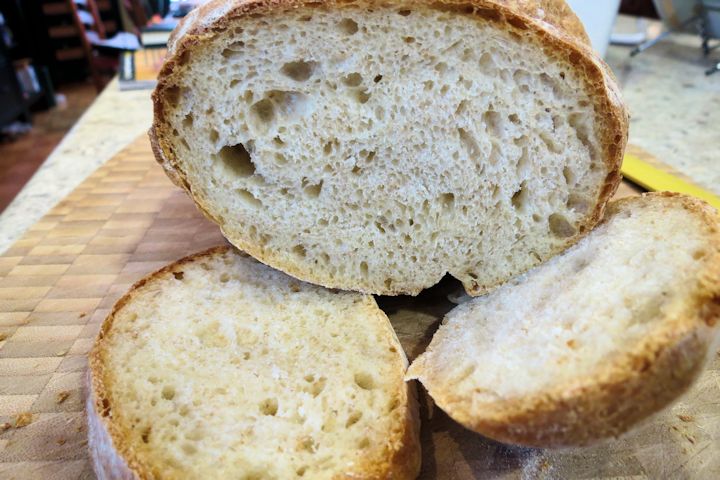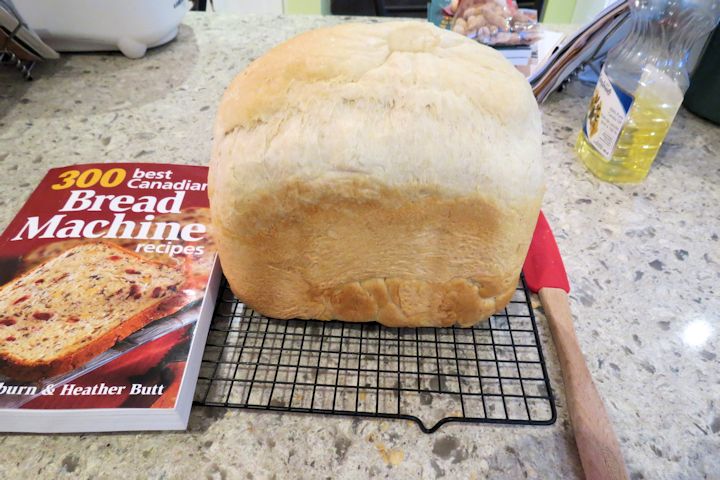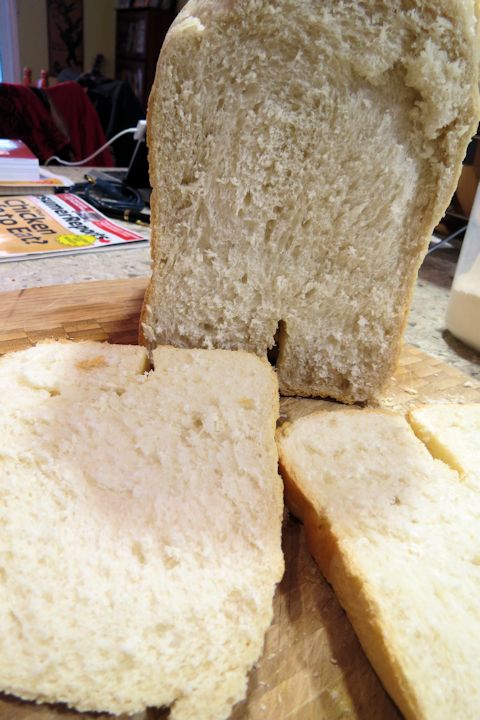![]()
 This past week saw several new experiments in my bread laboratory. Okay, it’s a kitchen, but sometimes it feels like a lab, what with all the tinkering and testing I do. I just can’t seem to stop trying new things in bread. It would fee even more science-like if Susan would let me buy the implements and tools I want.
This past week saw several new experiments in my bread laboratory. Okay, it’s a kitchen, but sometimes it feels like a lab, what with all the tinkering and testing I do. I just can’t seem to stop trying new things in bread. It would fee even more science-like if Susan would let me buy the implements and tools I want.
First, however, the good news: my levain remains thriving and healthy. I have two batches now: one on the counter, the other in the fridge. The counter batch is used as a poolish right now; the fridge is the long-term colony.
I used most of the counter colony last week to make a mixed-yeast bread, based somewhat on a recipe in Peter Reinhart’s book, Artisan Breads Every Day. I’ve since restored the levain to fuller size by feeding, and will use it again this week for another mixed-yeast loaf; this one with some tweaks.
You can read some of Reinhart’s ideas about bread, poolish, hydration and cold fermentation here in this PDF file. Or check his blog for ideas and new recipes. I really enjoy Reinhart’s writing and recommend his books. There’s always something to learn in them.
The idea of mixing the two yeasts intrigued me. I’ve learned a lot about pore-ferments and cold fermentation since I started baking. Reinhart writes:
The use of old dough or pre-fermented sponges was developed by traditional bakers as a way of slowing down fermentation and, essentially, buying the dough more time to release its flavor (a result of starch molecules releasing some of their sugar and saccharide chains, as well as the formation of acids due to fermentation by yeast and bacteria). Some of these pre-ferments are wet and batterlike, while others are dry and firm; some are made with commercial yeast, while others use naturally occurring wild yeast (sourdough starters); some have salt, and some don’t. What they all have in common is the idea of adding older, slowly fermented dough to young, freshly made dough to instantly age it so that greater flavor can be developed in less time. This is an example of the manipulation of time by the manipulation of ingredients.
 My pure wild-yeast loaf (aka sourdough) was a delicious success, as I wrote earlier. That encouraged me to try a mix of commercial and wild yeasts. Essentially, the counter levain was combined with an overnight poolish, and both were added to the dough for a bread. And when I mixed the dough before baking, I added extra dry yeast (although first proofed in lukewarm water).
My pure wild-yeast loaf (aka sourdough) was a delicious success, as I wrote earlier. That encouraged me to try a mix of commercial and wild yeasts. Essentially, the counter levain was combined with an overnight poolish, and both were added to the dough for a bread. And when I mixed the dough before baking, I added extra dry yeast (although first proofed in lukewarm water).
Sourdough makes a very flavourful bread, but on that may not be to everyone’s taste, or suitable for all uses. And it can sometimes be almost too sour or taste like a rye bread. But perhaps instead of a loaf made entirely of sourdough, a mixed-yeast loaf would give enough flavour without overwhelming it. But would it be overkill to mix a poolish in as well?
A pre-ferment like a poolish adds flavour, so does a sourdough starter. Reinhart writes:
…the function of each of these pre-ferments is relatively the same: to produce a better-tasting loaf by evoking the full flavor potential trapped in the grain
I’ve had success making bread with a poolish, but I wanted to enhance it with sourdough. So I mixed some in, roughly 150 grams.
My biggest question was: what is the hydration level? My levain is not made scientifically, rather by sight and feel. How much water is in it? I don’t know. I guessed the hydration was about 100%, maybe even a bit more. So I withheld some water from the dough to compensate. Not sure if that was really necessary, since the dough was tacky and probably should have been a little more sticky.
The dough, however, rose reasonably well – a good sign, but it was late in the day and time wasn’t on my side. I heated the oven and put the dough on the stone probably thirty minutes to an hour too soon. The result: mixed oven spring. Part of the loaf rose beautifully, but one end seemed stunted. I also used the lame to cut some slices across the top and sliced into an air pocket at that end, which likely affected the rise. I baked it for 35 minutes in the convection setting of 475F, reduced to 450 for the last 15 or so minutes.
Nonetheless, the crumb was good – although it would have benefitted from another hour’s rise – the texture not too dense and nicely chewy. The crust is crunchy and the flavour… wow! Enough sourdough to give it a pleasant bite, not too strong, but noticeable. It seems the mix can work.
I was very pleased by the loaf; one of my best yet. I needs some improvements, of course, but the premise is solid. I plan to make a new one along this line this week, once my current bread is finished. Like most of my loaves, I mixed unbleached white and whole wheat flours, about 20% whole wheat. i might try a straight white loaf next, using the poolish and levain mix.
 The second loaf was based on a recipe for French bread in the 300 Best Canadian Bread Machine Recipes cookbook. I stuck to the recipe… more or less.
The second loaf was based on a recipe for French bread in the 300 Best Canadian Bread Machine Recipes cookbook. I stuck to the recipe… more or less.
I reduced the salt, which would have been okay, had I also reduced the amount of yeast. But I also reduced the sugar, and added about a teaspoon of skim milk powder. Used the machine’s French bread, 2 lb loaf, mid-crust setting.
The result was a tall, fluffy loaf. So tall it actually touched the inside of the machine’s viewing port.
Way too tall! Standing inches above the toaster when toasting. Too tall for practical use. Cut in half and toasted, it made for great beans-on-toast lunches, and went well with Susan’s stew this weekend. But clearly I should have either added more salt or reduced the yeast. But what would that have done to the crumb?
The crust is nice, not chewy at all, and pleasantly crisp when toasted. The crumb is spongy as expected, much like commercial bread, and toasts reasonably well, although it doesn’t slice as nicely as my artisan, denser loaves. Taste: not bad, not as bland as a typical commercial dinner-roll or white bread. Not really the rich and complex flavours I have come to expect in my other breads, but it seems a workable recipe that can easily be enhanced.
 You can see in the photo to the right the slot where the machine’s paddle was. I had to pry one of the paddles out of the loaf after baking – a minor nuisance that one lives with, with most bread machines. It can make a bit of a mess at the bottom of the loaf if too firmly embedded.
You can see in the photo to the right the slot where the machine’s paddle was. I had to pry one of the paddles out of the loaf after baking – a minor nuisance that one lives with, with most bread machines. It can make a bit of a mess at the bottom of the loaf if too firmly embedded.
The topmost part of the loaf, especially where it touched the port, was the least cooked (as expected). That’s another problem with tall loaves in machines. The heat comes from an element at the bottom, and the air at the top may not be hot enough to properly bake the highest part. I don’t know of any bread machine that has an upper-level element to heat the top part of the bread, but it might be a good idea.
I want to try several recipes in the bread machine, in part to see what sort of product they create and what, if anything, I can do to enhance them. I also want to test it as a dough maker, which I may do with the next mixed-yeast loaf. I will try this loaf again, but I think I’ll add a poolish to it because it needs some boost to its flavour.
Always something to tinker with. If only I could eat it as fast as I can bake it!

